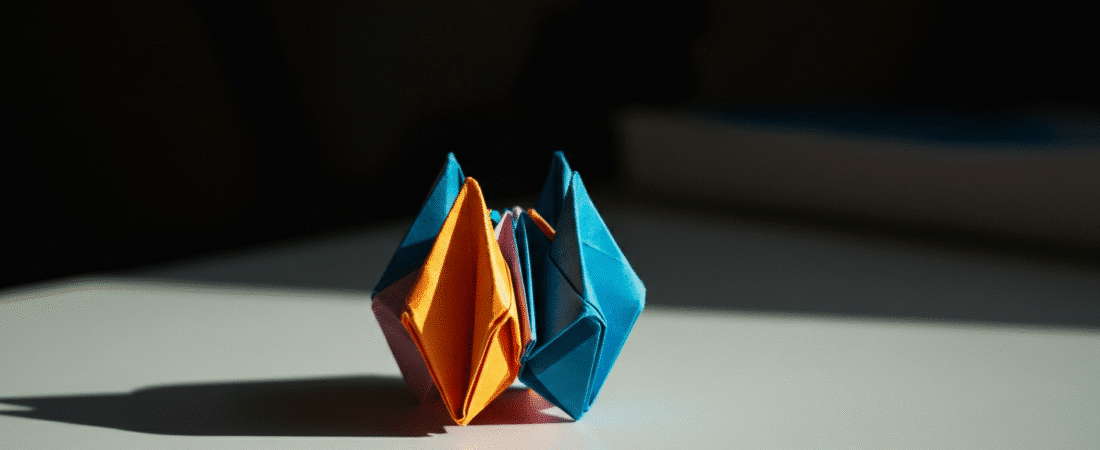Key Takeaways
- Yes, you can absolutely do origami with construction paper, though it’s thicker than traditional origami paper
- Construction paper works best for simple to intermediate origami models with fewer complex folds
- The thickness makes it more durable and beginner-friendly, but can be challenging for intricate designs
- Choose thinner construction paper (around 60-80 gsm) for better folding results
- Construction paper is an excellent alternative when traditional origami paper isn’t available
If you’ve ever wondered whether you can create beautiful origami with construction paper, the answer is a resounding yes! While traditional origami paper (called kami) remains the gold standard for paper folding, construction paper offers a practical and accessible alternative that works wonderfully for many origami projects. This comprehensive guide will explore everything you need to know about using construction paper for your origami creations, from understanding its properties to mastering the best techniques for success.
Whether you’re a beginner looking for an affordable way to start your origami journey, a teacher seeking classroom-friendly materials, or simply someone who wants to try origami without investing in specialty folding paper, construction paper can be your gateway to this ancient Japanese art form. Let’s dive into the world of construction paper origami and discover how to make the most of this versatile material.
- What is Construction Paper and How Does it Compare to Origami Paper?
- Advantages of Using Construction Paper for Origami
- Limitations When Using Construction Paper
- Best Origami Models for Construction Paper
- Tips for Successfully Folding Construction Paper
- How to Prepare Construction Paper for Origami
- Alternative Papers to Consider
- FAQ
- What’s the thickest paper that still works for origami?
- Can you make complex origami models like insects or detailed flowers with construction paper?
- How do you prevent construction paper from tearing at stress points?
- Is construction paper suitable for wet-folding techniques?
- What age is appropriate for children to start using construction paper for origami?
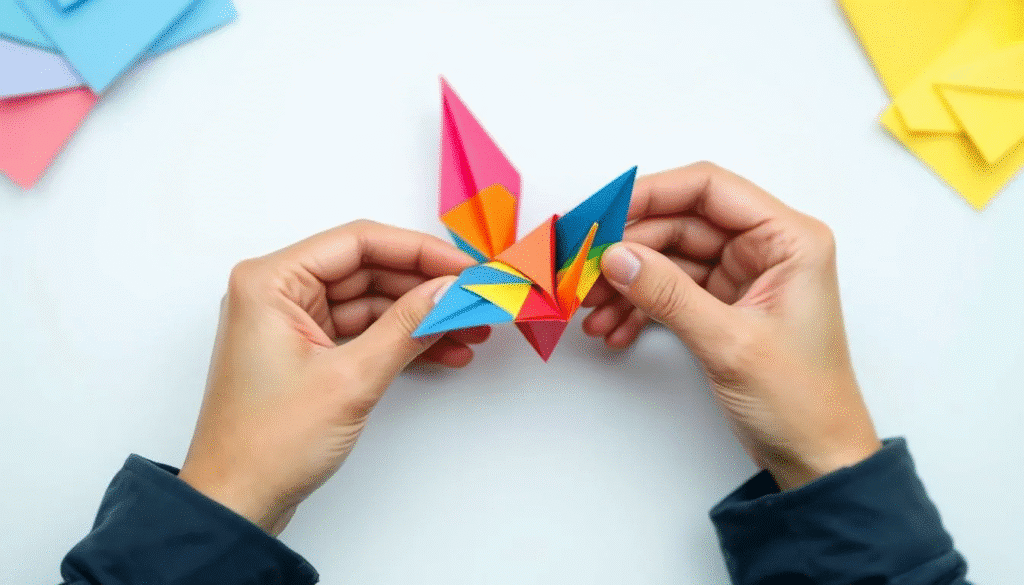
What is Construction Paper and How Does it Compare to Origami Paper?
Construction paper is a thick, slightly textured paper commonly used for arts and crafts projects in schools and homes worldwide. Understanding its properties compared to traditional origami paper helps explain both its potential and limitations for paper folding. Origami paper is traditionally thinner than standard office paper, making it easier to fold and achieve precise creases.
Traditional origami paper, known as kami, typically weighs between 40-50 grams per square meter (gsm), while construction paper usually ranges from 60-80 gsm. This difference in weight significantly impacts how the paper behaves during folding. The thicker construction paper provides more resistance when creating folds, requiring more pressure to achieve sharp creases.
The texture also differs considerably. Origami paper features a smooth surface that allows for precise folding and clean lines, while construction paper has a slightly rougher, more fibrous texture. This rougher surface can create more friction during the folding process, but it also helps the paper hold creases once they’re formed.
Construction paper comes in vibrant colors and larger sheet sizes than traditional origami paper. Standard construction paper sheets measure 9×12 inches or 12×18 inches, compared to the typical 6×6 inch squares of origami paper. Traditional origami paper comes in various colors and sometimes has patterns on both sides, adding to its aesthetic appeal.
From a cost perspective, construction paper wins hands down. A pack of 50 sheets of construction paper costs significantly less than specialty origami paper, making it an economical choice for beginners, teachers, or anyone wanting to practice without worrying about wasting expensive materials.
Advantages of Using Construction Paper for Origami
Construction paper offers several compelling advantages that make it an excellent choice for many origami enthusiasts, particularly those new to the art form.
Durability and Forgiveness
The thickness of construction paper makes it much more durable than thin origami paper. Beginners often struggle with tearing delicate kami during their first attempts at folding. Construction paper’s robust nature means you can fold, unfold, and refold multiple times without worrying about rips or tears. This forgiving quality makes it perfect for learning basic origami techniques and practicing new models.
Accessibility and Availability
Unlike specialty origami paper, which may require ordering online or visiting specific craft stores, construction paper is available virtually everywhere. Office supply stores, grocery stores, pharmacies, and schools all typically stock construction paper. This widespread availability means you can start your origami project immediately without waiting for special materials to arrive.
Cost-Effectiveness
For teachers working with entire classrooms or parents entertaining multiple children, the cost difference becomes significant. A single pack of construction paper can provide dozens of origami projects, while the same budget might only cover a handful of traditional origami paper sheets. This affordability encourages experimentation and reduces the pressure to create perfect models on the first try.
Bold Visual Impact
Construction paper’s vibrant colors create striking finished models that stand out beautifully. The bright reds, blues, greens, and yellows available in construction paper packs can make your origami creations more visually appealing than traditional white or subtly colored origami paper. This bold aesthetic particularly appeals to children and makes great decorative pieces.
Size Flexibility
The larger format of construction paper allows you to cut squares of various sizes, from small 4×4 inch squares for delicate models to large 10×10 inch squares for impressive display pieces. This flexibility in sizing helps accommodate different projects and skill levels.
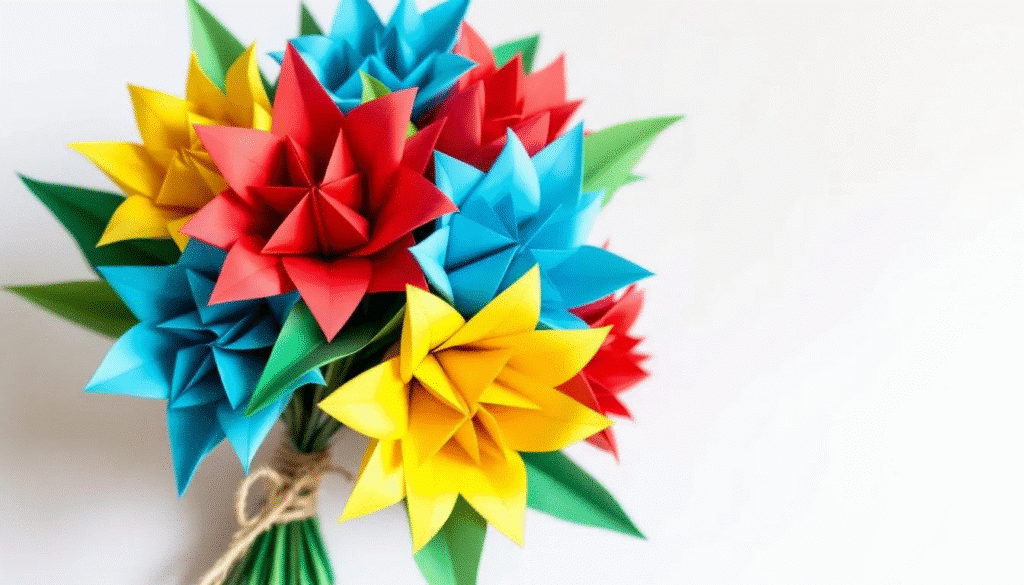
Limitations When Using Construction Paper
While construction paper works well for many origami projects, it’s important to understand its limitations to set realistic expectations and choose appropriate models.
Thickness Challenges
The primary limitation of construction paper is its thickness. When multiple layers overlap in complex models, the bulk can become problematic. Models requiring numerous reverse folds, sink folds, or intricate layering may become too thick to fold properly. The paper simply doesn’t compress as neatly as thin origami paper.
Precision Difficulties
Construction paper’s thickness and texture can make it challenging to achieve the razor-sharp creases that define elegant origami. While you can create clear folds, they may not be as crisp or precise as those possible with traditional kami. This limitation becomes more noticeable in models where perfect geometry is crucial.
Bulky Appearance
In areas where many folds converge, construction paper can create a bulky, somewhat ungainly appearance. Traditional origami paper maintains a more refined look even with multiple layers, while construction paper may appear chunky or amateur in complex models.
Limited Flexibility
The thickness of construction paper reduces its flexibility, making certain advanced folding techniques more difficult or impossible. Techniques requiring the paper to bend in complex curves or hold delicate shapes may not work well with construction paper’s more rigid nature.
Crease Memory Issues
While construction paper holds basic creases well, it may not maintain the subtle “memory” that allows traditional origami paper to spring back into shape or hold complex three-dimensional forms as effectively.
Best Origami Models for Construction Paper
Choosing the right models is key to success when working with construction paper. Focus on designs that work with the material’s strengths while avoiding its limitations.
Simple Animals and Characters
Construction paper excels with straightforward animal designs that don’t require excessive layering. A classic origami frog works beautifully, as does a simple turtle or basic bird design. Origami models such as cranes, frogs, and turtles are simple to fold and suitable for beginners. These models typically involve 10-20 steps and create charming results that showcase construction paper’s vibrant colors.
Geometric Shapes and Practical Items
Boxes, bookmarks, and simple geometric forms are perfect for construction paper. The material’s durability makes these practical origami items more functional than those made from delicate traditional paper. Easy origami flowers with basic petal structures also work well, creating lovely decorative elements for gifts or displays.
Traditional Beginner Models
Classic introductory models like paper boats, hats, and fortune tellers (also known as cootie catchers) are ideal for construction paper. These designs were originally created with whatever paper was available, so they adapt naturally to different materials. The larger size possible with construction paper actually enhances these playful models.
Holiday Decorations | The Best Birthday Decorations Paper for Your Celebration Needs
Construction paper’s bright colors make it perfect for seasonal origami. Simple Christmas stars, basic snowflakes, Halloween bats, and other holiday decorations benefit from the bold colors and increased durability that construction paper provides.
Modular Origami
Modular origami, where multiple identical units combine to create larger structures, works exceptionally well with construction paper. The material’s strength helps the assembled pieces hold together better than delicate traditional paper, creating stable, impressive final models.
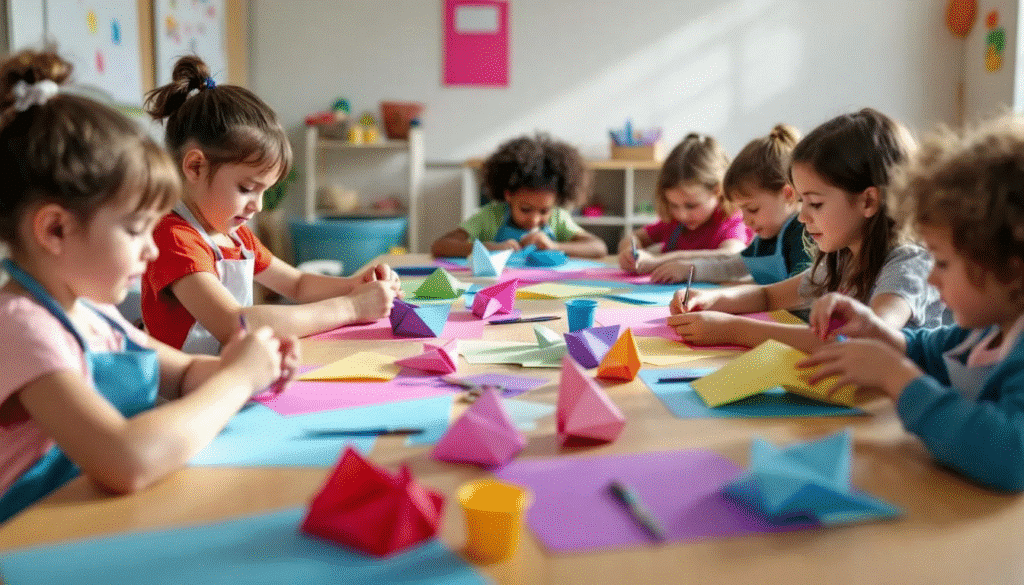
Tips for Successfully Folding Construction Paper
Mastering construction paper origami requires adapting your technique to work with the material’s unique properties. These tips will help you achieve the best possible results.
Choose Your Paper Wisely
Not all construction paper is created equal. Look for thinner varieties in the 60-65 gsm range when possible. Some brands offer “lightweight” construction paper that folds more easily while maintaining durability. Avoid the heaviest construction paper (over 80 gsm) for origami projects.
Create Sharp, Deliberate Creases
Construction paper requires more pressure than traditional origami paper to form clean creases. Use your fingernail, a bone folder, or even the edge of a ruler to press firmly along fold lines. Work slowly and deliberately, ensuring each crease is sharp and well-defined before moving to the next step.
Start Simple and Progress Gradually
Begin with models requiring 15 steps or fewer, then gradually work up to more complex designs as you become comfortable with the material. This progression helps you understand how construction paper behaves and builds confidence for tackling more challenging projects.
Pre-score Complex Fold Lines
For models with particularly challenging folds, consider lightly scoring the fold lines with a blunt tool before attempting to fold. This technique, while not traditional in origami, can help construction paper fold more cleanly and precisely.
Work with Larger Squares
Starting with larger squares (8×8 inches or bigger) gives you more room to work and makes handling the thicker paper easier. As you become more comfortable, you can work down to smaller sizes.
Be Patient with Multiple Layers
When folding areas with multiple layers, work slowly and apply steady pressure. Don’t force the paper; instead, work gradually to compress the layers evenly.
How to Prepare Construction Paper for Origami
Most origami models require square paper, but construction paper typically comes in rectangular sheets. Here’s how to create perfect squares from rectangular construction paper. To make origami paper from rectangular printer paper, first fold the top right corner down to align with the left edge to form a triangle.
The Corner-to-Edge Method
Start with a rectangular sheet of construction paper. Fold the top left corner down diagonally until it aligns with the right edge of the paper, creating a triangle with a rectangular excess at the bottom. The fold line should be perpendicular to the right edge.
Press the fold firmly, then use scissors to cut along the bottom edge of the triangle, removing the excess rectangular strip. When you unfold the triangle, you’ll have a perfect square ready for origami folding.
Measuring and Cutting Method
For multiple squares or when precision is critical, measure the width of your construction paper and mark that same distance along the length. Use a ruler to draw a light pencil line, then cut along this line to create a square. Erase any visible pencil marks before folding.
Size Considerations
For beginners, squares between 8×8 and 10×10 inches work best with construction paper. This size provides enough material to handle comfortably while keeping the paper manageable. Advanced folders might prefer 6×6 inch squares for more detailed work.
Creating Multiple Squares
A standard 12×18 inch sheet of construction paper can yield multiple squares of various sizes. Plan your cuts carefully to minimize waste and create the sizes you need for your projects.
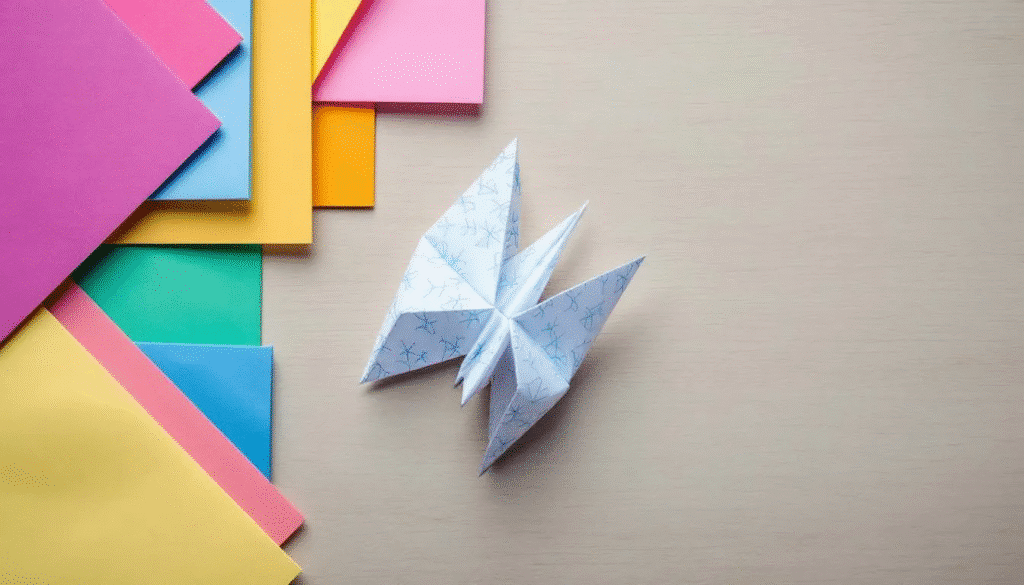
Alternative Papers to Consider
While construction paper works well for many projects, exploring other accessible alternatives can expand your origami possibilities. Pages from old books or maps can be used for origami because they are typically made of thin paper, offering a unique and creative option for folding. For further inspiration, check out these vintage paper craft ideas.
Printer Paper and Copy Paper
Standard 20-pound copy paper (around 75 gsm) offers a middle ground between construction paper and traditional origami paper. It’s thinner than construction paper but still readily available and inexpensive. Printer paper holds creases well and works for intermediate-level models.
Thin gift wrap provides an excellent origami medium, often featuring beautiful patterns and designs. The paper is typically much thinner than construction paper while still being durable enough for most projects. Just ensure the gift wrap isn’t too glossy, as this can make folding difficult.
Scrapbook Paper
Quality scrapbook paper and handmade paper sheets combine attractive designs with good folding properties. While more expensive than construction paper, it offers professional-looking results and often comes in 12×12 inch squares that require no cutting.
Magazine Pages
Glossy magazine pages work surprisingly well for practice and casual projects. They’re free, colorful, and have interesting patterns and images. The slight coating helps them hold creases, though they can be slippery to work with initially.
Tissue Paper
For delicate, translucent effects, tissue paper creates beautiful origami flowers and decorative elements. While much more fragile than construction paper, it offers unique aesthetic possibilities for special projects.
Newspaper and Newsprint
Large newspaper sheets allow for oversized origami models and provide excellent practice material. The large format is perfect for learning new techniques before attempting them with better paper.
FAQ
What’s the thickest paper that still works for origami?
Construction paper at 80 gsm represents about the upper limit for most origami projects. Beyond this thickness, the paper becomes too bulky for clean folding and layer management. For best results, stick to construction paper in the 60-65 gsm range, which provides durability while maintaining reasonable foldability.
Can you make complex origami models like insects or detailed flowers with construction paper?
Complex models with intricate details, numerous small folds, or many overlapping layers are generally not suitable for construction paper. The thickness creates too much bulk in areas with multiple layers, and the reduced precision makes fine details difficult to achieve. Stick to models with 20 steps or fewer for best results with construction paper.
How do you prevent construction paper from tearing at stress points?
Construction paper rarely tears during normal folding due to its thickness and fiber content. However, to prevent issues, avoid forcing folds and work gradually when compressing multiple layers. If you notice stress at a particular fold, try reinforcing it by refolding more gently or adjusting your technique to distribute pressure more evenly.
Is construction paper suitable for wet-folding techniques?
Construction paper is not recommended for wet-folding techniques. Its high lignin content and fiber composition can cause it to become mushy, lose strength, or discolor when dampened. Wet-folding requires specific papers designed to maintain integrity when moist, such as high-quality handmade papers or specially treated origami papers.
What age is appropriate for children to start using construction paper for origami?
Children as young as 5-6 years old can successfully use construction paper for simple origami projects with adult guidance. The material’s durability and forgiving nature make it ideal for young learners. Start with very basic models like paper boats or simple hats, then progress to more complex designs as their fine motor skills and patience develop. Happy folding!


